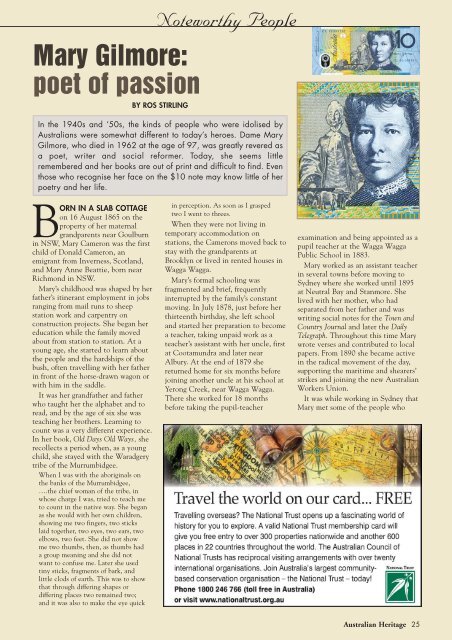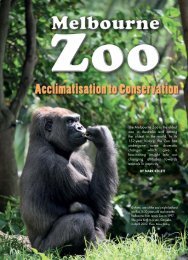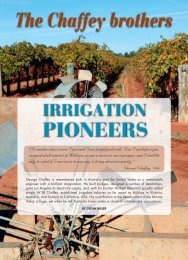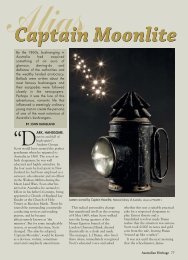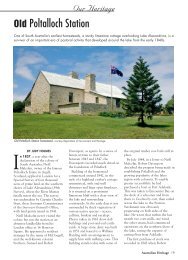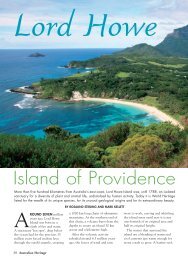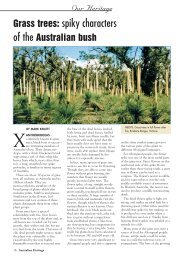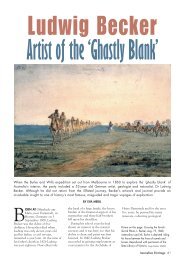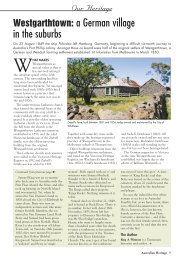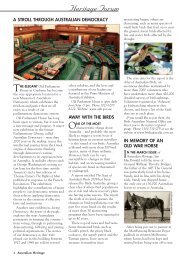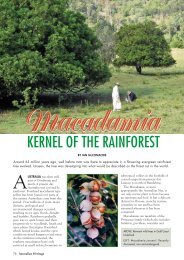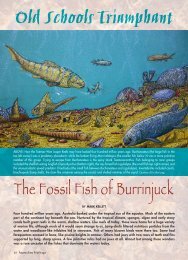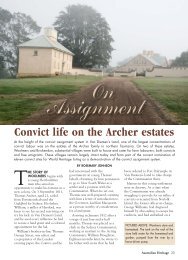Heritage1206_Noteworthy Mary Gilmore.pdf - Australian Heritage ...
Heritage1206_Noteworthy Mary Gilmore.pdf - Australian Heritage ...
Heritage1206_Noteworthy Mary Gilmore.pdf - Australian Heritage ...
You also want an ePaper? Increase the reach of your titles
YUMPU automatically turns print PDFs into web optimized ePapers that Google loves.
<strong>Noteworthy</strong> People<br />
<strong>Mary</strong> <strong>Gilmore</strong>:<br />
poet of passion<br />
BY ROS STIRLING<br />
In the 1940s and ‘50s, the kinds of people who were idolised by<br />
<strong>Australian</strong>s were somewhat different to today’s heroes. Dame <strong>Mary</strong><br />
<strong>Gilmore</strong>, who died in 1962 at the age of 97, was greatly revered as<br />
a poet, writer and social reformer. Today, she seems little<br />
remembered and her books are out of print and difficult to find. Even<br />
those who recognise her face on the $10 note may know little of her<br />
poetry and her life.<br />
BORN IN A SLAB COTTAGE<br />
on 16 August 1865 on the<br />
property of her maternal<br />
grandparents near Goulburn<br />
in NSW, <strong>Mary</strong> Cameron was the first<br />
child of Donald Cameron, an<br />
emigrant from Inverness, Scotland,<br />
and <strong>Mary</strong> Anne Beattie, born near<br />
Richmond in NSW.<br />
<strong>Mary</strong>’s childhood was shaped by her<br />
father’s itinerant employment in jobs<br />
ranging from mail runs to sheep<br />
station work and carpentry on<br />
construction projects. She began her<br />
education while the family moved<br />
about from station to station. At a<br />
young age, she started to learn about<br />
the people and the hardships of the<br />
bush, often travelling with her father<br />
in front of the horse-drawn wagon or<br />
with him in the saddle.<br />
It was her grandfather and father<br />
who taught her the alphabet and to<br />
read, and by the age of six she was<br />
teaching her brothers. Learning to<br />
count was a very different experience.<br />
In her book, Old Days Old Ways, she<br />
recollects a period when, as a young<br />
child, she stayed with the Waradgery<br />
tribe of the Murrumbidgee.<br />
When I was with the aboriginals on<br />
the banks of the Murrumbidgee,<br />
….the chief woman of the tribe, in<br />
whose charge I was, tried to teach me<br />
to count in the native way. She began<br />
as she would with her own children,<br />
showing me two fingers, two sticks<br />
laid together, two eyes, two ears, two<br />
elbows, two feet. She did not show<br />
me two thumbs, then, as thumbs had<br />
a group meaning and she did not<br />
want to confuse me. Later she used<br />
tiny sticks, fragments of bark, and<br />
little clods of earth. This was to show<br />
that through differing shapes or<br />
differing places two remained two;<br />
and it was also to make the eye quick<br />
in perception. As soon as I grasped<br />
two I went to threes.<br />
When they were not living in<br />
temporary accommodation on<br />
stations, the Camerons moved back to<br />
stay with the grandparents at<br />
Brooklyn or lived in rented houses in<br />
Wagga Wagga.<br />
<strong>Mary</strong>’s formal schooling was<br />
fragmented and brief, frequently<br />
interrupted by the family’s constant<br />
moving. In July 1878, just before her<br />
thirteenth birthday, she left school<br />
and started her preparation to become<br />
a teacher, taking unpaid work as a<br />
teacher’s assistant with her uncle, first<br />
at Cootamundra and later near<br />
Albury. At the end of 1879 she<br />
returned home for six months before<br />
joining another uncle at his school at<br />
Yerong Creek, near Wagga Wagga.<br />
There she worked for 18 months<br />
before taking the pupil-teacher<br />
examination and being appointed as a<br />
pupil teacher at the Wagga Wagga<br />
Public School in 1883.<br />
<strong>Mary</strong> worked as an assistant teacher<br />
in several towns before moving to<br />
Sydney where she worked until 1895<br />
at Neutral Bay and Stanmore. She<br />
lived with her mother, who had<br />
separated from her father and was<br />
writing social notes for the Town and<br />
Country Journal and later the Daily<br />
Telegraph. Throughout this time <strong>Mary</strong><br />
wrote verses and contributed to local<br />
papers. From 1890 she became active<br />
in the radical movement of the day,<br />
supporting the maritime and shearers’<br />
strikes and joining the new <strong>Australian</strong><br />
Workers Union.<br />
It was while working in Sydney that<br />
<strong>Mary</strong> met some of the people who<br />
<strong>Australian</strong> <strong>Heritage</strong> 25
<strong>Noteworthy</strong> People<br />
were to have the greatest influence on<br />
her life – William Lane, the founder of<br />
New Australia, the socialist<br />
community in Paraguay; Louisa<br />
Lawson, who was friendly with her<br />
mother; and through Louisa, her son,<br />
Henry Lawson. A strong attachment<br />
grew between <strong>Mary</strong> and Henry and,<br />
according to <strong>Mary</strong>, “he said he fell in<br />
love with me at first sight”.<br />
The two spent much time in each<br />
other’s company, and Henry<br />
introduced <strong>Mary</strong> to the poorer<br />
working class areas of Sydney<br />
including the Rocks area.<br />
He used to take me out to see the<br />
wrong things, the things repressive of<br />
the rights of Australia; the things like<br />
a blot upon her and which prevented<br />
her being herself – the low wage<br />
workers, the Chinamen working at<br />
treadle-saws in underground cellars lit<br />
only by a grating in the street, the<br />
huddled houses by the old Argyle Cut,<br />
and the Rocks where women hung<br />
their washing out on the roof and<br />
from the windows, and where pale<br />
seamstresses sewed at a foot or a hand<br />
machine from daylight till dark for a<br />
few pence and, last but not least, the<br />
mixture of blood and the neglected<br />
children of the Quay and elsewhere.<br />
<strong>Mary</strong> later wrote that Henry<br />
proposed to her but she refused.<br />
1890 was a tumultuous year for<br />
Australia, with the growth of the<br />
trade union movement and the<br />
formation of employers’ groups<br />
leading to the maritime strike which<br />
spread across the nation in August of<br />
that year. Foremost among the union<br />
leaders was William Lane, an<br />
Englishman who had emigrated in<br />
1885 to Brisbane, where he worked as<br />
a freelance journalist for mainstream<br />
and workers’ publications, and<br />
launched his own socialist newspaper,<br />
The Boomerang.<br />
He played a leading role in growing<br />
the Queensland union movement and<br />
edited the union newspaper, The<br />
Worker. Following the collapse of the<br />
Shearers’ Strike in 1891, and<br />
disillusioned with the entrenched<br />
social and economic divide in<br />
Australia, Lane and a handful of other<br />
socialists founded The ‘New Australia<br />
Cooperative Settlement Association’<br />
with the aim of creating a utopian<br />
communist society.<br />
The group decided it would be<br />
necessary to leave Australia and<br />
Paraguay was settled upon when a<br />
parcel of land was offered by the<br />
Paraguayan government on condition<br />
that a minimum number of people<br />
settled there. The Association set<br />
about attracting recruits to the new<br />
colony and acquiring a ship, the Royal<br />
Tar, to transport them.<br />
It was in 1892 that <strong>Mary</strong> Cameron<br />
met and was evidently deeply<br />
impressed by William Lane.<br />
Earnest, strong in conviction,<br />
generous-hearted and tender-hearted.<br />
A man to whom Truth is more than<br />
all else – not only truth in word and<br />
deed but in the fulfillment of creation.<br />
….A man with whom utter kindliness<br />
abides. It is good to have touched his<br />
hand.<br />
When the headquarters of the New<br />
Australia Co-operative Settlement<br />
Association moved to Sydney in 1893,<br />
<strong>Mary</strong> started writing for its journal,<br />
New Australia. Meanwhile, somewhat<br />
chaotic preparations were under way<br />
for the first group of 220 emigrants to<br />
be shipped to Paraguay, and they<br />
finally set sail under Lane’s leadership<br />
on 16 July 1893. <strong>Mary</strong> was unable to<br />
join them as single women were<br />
excluded from this first trip.<br />
Over the following months, <strong>Mary</strong><br />
became a key protagonist for the new<br />
settlement, but all was not well within<br />
the emigrant community. Even during<br />
the voyage, signs of discord emerged as<br />
some of the settlers expressed<br />
resentment at Lane’s strict moral code<br />
and somewhat authoritarian attitude.<br />
Things got worse after their arrival in<br />
September and, by mid-December,<br />
Lane had expelled three men for<br />
breaking the temperance rule. By the<br />
end of the year, more than a third of<br />
the settlers had seceded. A second<br />
group of 199 emigrants set out from<br />
Adelaide on New Year’s Eve, arriving<br />
in late February 1894, but their arrival<br />
A group of people, including <strong>Mary</strong> <strong>Gilmore</strong>, at the New Australia Colony, Cosme, Paraguay, 1890s. Photograph; 10.1 x 15.5 cm. National Library of<br />
Australia, nla.pic-an24636968.<br />
26 <strong>Australian</strong> <strong>Heritage</strong>
<strong>Noteworthy</strong> People<br />
Portrait of Dame <strong>Mary</strong> <strong>Gilmore</strong>, 1928, Adelaide Perry, 1891–1973, oil on plywood panel on<br />
composition board; 45.3 x 35.5 cm. National Library of Australia, nla.pic-an2292680.<br />
did nothing to restore harmony. By<br />
May, Lane and sixty or so supporters<br />
were outnumbered and themselves<br />
seceded to set up a new settlement<br />
called Cosme 72 km from New<br />
Australia, and about 20 km from the<br />
nearest village.<br />
Meanwhile, back in Australia, <strong>Mary</strong><br />
briefly became editor of New<br />
Australia, but news of the split in<br />
Paraguay caused confusion and<br />
factionalism within the Association.<br />
<strong>Mary</strong> cut her links with it as she<br />
prepared to join Lane and the settlers<br />
at Cosme, leaving Sydney in<br />
November 1895.<br />
After an adventurous journey, she<br />
arrived at the new settlement in<br />
January 1896. In the 18 months since<br />
its foundation, Cosme had come a<br />
long way from the primitive camp of<br />
its first settlers, but it was still very<br />
basic. <strong>Mary</strong> described the little house<br />
that was built for her:<br />
grass walls, grass windows, grass roof.<br />
It had no fireplace. No door. Floor of<br />
clay. If you sat too long on a stool (no<br />
chairs) the legs of the stool sank<br />
inches into the floor.<br />
In the hot, humid climate, the<br />
settlers were plagued by insects,<br />
spiders, snakes and disease, but still<br />
the colony grew. <strong>Mary</strong>, now 31, was<br />
keen to marry, and she soon<br />
announced her engagement to<br />
William <strong>Gilmore</strong>, a shearer and farm<br />
labourer who had come to Paraguay<br />
with the second group of emigrants<br />
from Adelaide. They were married in<br />
May 1897 and, in August of the<br />
following year, their only child, Billy,<br />
was born. During this period, Lane<br />
had been away in England recruiting<br />
new settlers to Cosme, and his<br />
absence had resulted in weakening of<br />
the community and its utopian vision.<br />
<strong>Mary</strong> suffered several bouts of fever<br />
and was becoming alarmed about her<br />
health and that of her son. Then in<br />
June 1899, evidently exhausted and<br />
disillusioned, Lane announced that he<br />
was leaving Cosme to settle in New<br />
Zealand. Will and <strong>Mary</strong> <strong>Gilmore</strong> also<br />
resigned from the colony and Will left<br />
for Argentina to work as a shearer in<br />
order to raise money for their return<br />
to Australia.<br />
During the three years that <strong>Mary</strong><br />
had been away, both her parents had<br />
died – her father, whom she had not<br />
seen in ten years, in November 1896,<br />
and her mother, at the age of fiftythree,<br />
just six weeks after Will and<br />
<strong>Mary</strong> made their decision to return to<br />
Australia.<br />
Getting back to Australia was no<br />
easy matter. First, <strong>Mary</strong> and Billy were<br />
unable to leave when the colony was<br />
quarantined following a suspected<br />
outbreak of bubonic plague. When<br />
they did get away, it was only to stay<br />
for several months at the nearby town<br />
of Villa Rica before catching a steamer<br />
for Rio Gallegos in Pategonia where<br />
<strong>Mary</strong> taught English and Will found<br />
work shearing on a station 80 km<br />
away.<br />
Finally, the money was raised to<br />
return to Australia via England and in<br />
March 1902, the family embarked on<br />
a difficult voyage during which all<br />
three were assailed by illness. Arriving<br />
in Liverpool with virtually no money,<br />
they heard that Henry Lawson and his<br />
wife Bertha were living in London.<br />
Henry, who by now was drinking<br />
heavily, invited the <strong>Gilmore</strong>s to stay.<br />
Bertha was unhappy with her lot and<br />
wanted only to return to Australia, so<br />
Henry arranged that she and their two<br />
children should return with the<br />
<strong>Gilmore</strong>s (it was to be the beginning<br />
of the end of the Lawsons’ marriage).<br />
Back in Melbourne, <strong>Mary</strong>’s longheld<br />
ambition to become a writer<br />
crystallised in her mind, but with the<br />
need to earn an income Will took<br />
labouring jobs in the country and<br />
<strong>Mary</strong> went with Billy first to live with<br />
her grandmother, <strong>Mary</strong> Beattie, in<br />
Junee, then with friends at Wagga<br />
Wagga and finally to Strathdownie<br />
near Casterton in Victoria where<br />
Will’s parents had a farm. Here, living<br />
<strong>Australian</strong> <strong>Heritage</strong> 27
<strong>Noteworthy</strong> People<br />
in a cottage on the farm, she felt<br />
totally isolated from any intellectual<br />
stimulation, but it was during this time<br />
that her literary career began to take<br />
off.<br />
The Bulletin had published one of her<br />
poems back in 1897 when she was in<br />
Paraguay, and the editor of the<br />
Bulletin’s Red Page, AG Stephens,<br />
undertook to publish a selection of<br />
poems. He began an enduring<br />
correspondence with <strong>Mary</strong>, sending<br />
her books and the literary journal,<br />
Bookfellow, without which, she later<br />
claimed, she would have broken down.<br />
It wasn’t till years later that I met him<br />
and I always feel that no gratitude and<br />
no good word I could ever give him<br />
could make up for what he did for me.<br />
He was a friend when I most needed<br />
one.<br />
Struggling to devote time to writing<br />
in days packed with domestic work in<br />
her remote and lonely home, <strong>Mary</strong><br />
waited in trepidation for the<br />
publication date, 1 October 1903,<br />
when fourteen of her poems, together<br />
with a photo and a brief profile,<br />
appeared in the Bulletin Red Page. It<br />
was to be a turning point in her life.<br />
She began sending her work to a<br />
variety of newspapers and journals, and<br />
over the next few years saw published<br />
articles about her life in Cosme,<br />
parenthood and children as well as a<br />
number of poems. In early 1907 the<br />
family moved to a cottage in Casterton<br />
where she contributed to the local<br />
newspaper and took an active role in<br />
the social and literary life of the town,<br />
including involvement in the local<br />
Labor Party branch and, at the<br />
invitation of the editor, founding and<br />
writing the Women’s Page of the<br />
Australia Worker.<br />
In 1910, <strong>Mary</strong>’s first book of verse,<br />
Marri’d and Other Verses, was published<br />
– 147 poems described by Stephens as<br />
‘little flutters’ on themes of life, love,<br />
motherhood and death.<br />
Will was meanwhile involved in<br />
building up properties he had jointly<br />
acquired with his brother in<br />
Queensland and was away for long<br />
stretches. Moving back to Sydney,<br />
<strong>Mary</strong> continued the Women’s Page,<br />
campaigning on issues such as the<br />
maternity bonus that was introduced<br />
in November 1912, age and invalid<br />
pensions and the treatment of<br />
Aboriginals, and writing on aspects of<br />
Australia at war from 1914, as well as<br />
offering advice on domestic affairs and<br />
remedies for common ailments.<br />
Another book of verse, The Passionate<br />
Heart, which expressed her horror at<br />
the war, secured <strong>Mary</strong>’s reputation as a<br />
leading poet.<br />
Billy had earlier moved to<br />
Queensland to work with his father,<br />
and <strong>Mary</strong> did not see either of them<br />
for more than a decade. Her health<br />
was increasingly threatened by high<br />
blood pressure and she moved to<br />
Goulburn for several years, during<br />
which period Henry Lawson died. In<br />
1925, a new book of verse, The Tilted<br />
Cart, about life in the Riverina, was<br />
published, drawing, to some degree, on<br />
her childhood memories. It was<br />
followed in 1930 by The Wild Swan<br />
which dealt mostly with death and<br />
reflections on the experiences and<br />
outcomes of life.<br />
By this time, <strong>Mary</strong> <strong>Gilmore</strong> had a<br />
considerable reputation as a writer and<br />
social commentator, and had been<br />
appointed to the Censorship Board.<br />
However, her employment with The<br />
Worker, which had lasted for 20 years,<br />
came to an unhappy end after a bitter<br />
falling out with the management. Over<br />
the next five years, through the Great<br />
Depression, <strong>Mary</strong> focused on<br />
publishing a series of books – two more<br />
books of verse and two of prose, Old<br />
Days, Old Ways; a Book of Recollections<br />
and More Recollections, which explored<br />
life in Australia’s pioneering days.<br />
In 1937, at the age of 72, <strong>Mary</strong> was<br />
recognised for her social and literary<br />
achievements with an appointment as<br />
the first Dame of the British Empire<br />
(DBE). She had become something of<br />
a living national treasure and enjoyed<br />
the limelight while working, over the<br />
next two years, on another book,<br />
Battlefields, which referred to inner<br />
personal battles rather than the<br />
looming war. When it came, the war<br />
absorbed her attention, as it did<br />
everyone’s, and she wrote numerous<br />
patriotic poems and even a battle cry –<br />
“We are the boomeranglanders” which,<br />
perhaps unsurprisingly, failed to catch<br />
on.<br />
1945 was to be a year of tragedy for<br />
<strong>Mary</strong>. For many years, she and Will<br />
had lived apart as he still ran his<br />
station in Queensland, and most years<br />
she heard from him only by mail. In<br />
February 1945, at the age of 78, Will<br />
died in Cloncurry hospital of<br />
septicaemia from an infected wound.<br />
Billy, now married with a son, and<br />
running another Queensland station,<br />
had become an alcoholic, and just five<br />
months after Will’s death, <strong>Mary</strong> was<br />
notified that her son had died from<br />
drinking benzine.<br />
While the grief was undoubtedly<br />
intense, <strong>Mary</strong> did not give in to it.<br />
With the war over she focused on the<br />
publication of her book, Selected Verse,<br />
and then her final collection, Fourteen<br />
Men. As a passionate pacificist, she<br />
became involved in a peace movement<br />
managed by the Communist Party and<br />
started writing for the communist<br />
paper, the Tribune, which she<br />
continued until the year of her death.<br />
Dame <strong>Mary</strong> <strong>Gilmore</strong> made a lasting<br />
impact on Australia through her<br />
writing and through her dedication to<br />
social reform. She enjoyed the<br />
friendship of and correspondence with<br />
many other authors such as Hugh<br />
McCrae, Miles Franklin, Frank Dalby<br />
Davison, Sir Lionel Lindsay and, of<br />
course, Henry Lawson.<br />
In her final years her public standing<br />
only increased. Numerous portraits<br />
were painted, her birthdays were<br />
celebrated, streets, schools and agedcare<br />
homes were named after her, and<br />
she appeared on radio and television<br />
and led May Day processions.<br />
<strong>Mary</strong> <strong>Gilmore</strong> died on 3 December<br />
1962, and was given a state funeral<br />
which, while she had seemingly always<br />
enjoyed and even sought the limelight,<br />
was perhaps the antithesis of her<br />
sentiments in a few lines of verse that<br />
she gave to Bill Wood, the associate<br />
editor of the Tribune, to publish after<br />
her death.<br />
When I am gone I ask<br />
No mighty ones to follow me;<br />
No lions, tigers, elephants or tall giraffes,<br />
But just the little ants –<br />
The little folk<br />
Who, day and night,<br />
Carry the burden of the small<br />
And save the world –<br />
These were my friends in life;<br />
In death they will remember me.<br />
Further Reading<br />
Courage a grace: a biography of Dame <strong>Mary</strong><br />
<strong>Gilmore</strong>, W H Wilde, Melbourne<br />
University Press 1988<br />
Old Days: Old ways, A book of recollections,<br />
<strong>Mary</strong> <strong>Gilmore</strong>, Angus & Robertson,<br />
1986 ◆<br />
28 <strong>Australian</strong> <strong>Heritage</strong>


